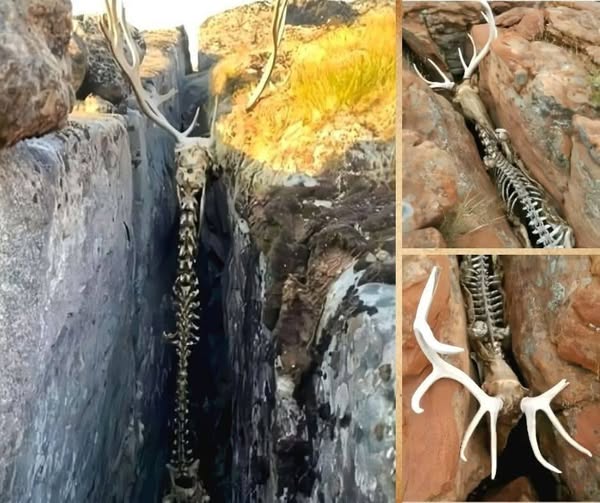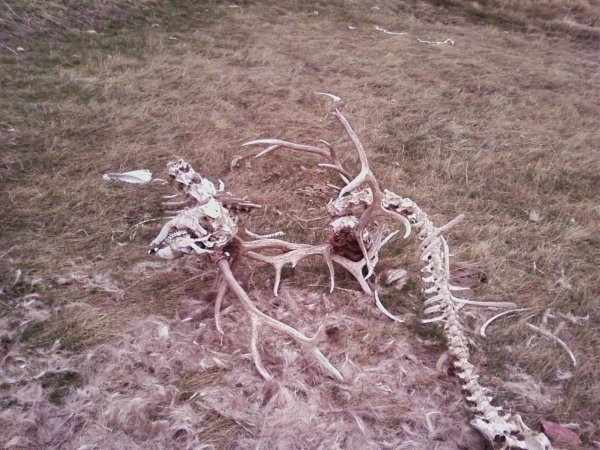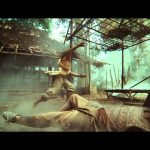A Deer’s Final Rest: Nature’s Brutal Beauty in the Wild

Bones in the Stone: A Silent Testament of the Wild
Hidden deep within the jagged folds of North America’s vast and unrelenting mountain ranges, there lies a story older than any human could comprehend—a story etched in bone, rock, and time. Within the narrow crevice between two great stone slabs, the skeletal remains of a deer rest, entombed in an eternal embrace with the land. Its bones, bleached white by the cruel sun and seasoned winds, stand in stark contrast to the reddish-brown rock that surrounds them. This strange pairing, the remains of a once graceful creature now bound forever to the stone, paints a haunting image of both beauty and loss.
This location is not merely a place of death—it is a solemn memorial. The animal, once vibrant with life and purpose, now exists as a mere fragment of memory, a ghost of the wild. Trapped, perhaps, by the very forces of nature that once shaped its existence, the deer found its final resting place here, where the landscape provided neither escape nor salvation. It is a stark reminder that survival is not guaranteed in the wild, and that every living creature must face its end, often in the most unexpected of ways.
The remains of this deer are not just bones—they are a silent witness to nature’s indifference. Time and the elements have worn away much of its flesh, leaving only the bare essentials of life. The antlers, once symbols of strength and dominance, have now become covered in cobwebs. These delicate threads, spun by the spiders that have claimed the space, weave a macabre veil over the antlers, as if the creatures of the earth are quietly marking the passing of an era. These bones are not forgotten, but they are slowly becoming part of the land once more.
The Art of Decay: A Haunting Beauty
Decay, often seen as a negative process, is transformed in this scene into something almost beautiful. The decomposition of the deer’s body has created a natural masterpiece—a tableau that tells the story of life, death, and rebirth. The bones, bleached and weathered, are not lifeless; they are a part of the circle of life that continues to turn, unbidden by human hands.
The landscape itself has become a witness to this transformation. The rocky terrain, shaped over millions of years by wind, rain, and the passage of time, is now home to the remains of this deer. In this remote corner of the world, far from the hustle and bustle of civilization, nature operates on its own terms. There is no interference here, no human intervention to ease the suffering or hurry the process of decay. The deer’s fate is its own, and in this, it finds a strange kind of peace.
As you gaze upon the skeletal remains, you cannot help but feel a sense of awe. The antlers, once so proud and full of promise, are now nothing more than relics of a bygone era. The bones, bleached by the sun, glint in the soft light, their stark whiteness a reminder of the power of time. The eerie calm that surrounds this site is not one of mourning, but of quiet acceptance—an acceptance of the inevitable cycle of life and death that governs the wild.

The Silent Storyteller
Though this deer has long since passed, its story is far from over. The skeletal remains serve as a silent storyteller, a narrator of the natural world. Each bone, each joint, each part of the skeleton, holds within it the story of this creature’s life. The deer’s antlers once spoke of strength, of survival, of territory and dominance. Now, they speak of the fragility of life, of how the strongest of creatures can fall prey to the elements and the forces of nature.
Yet, even in its death, the deer’s story is not one of defeat. Its remains are not simply a marker of the end but a testament to the beauty and fragility of the natural world. Nature, in its wisdom, has a way of turning death into something new. The bones of the deer will eventually return to the earth, nourishing the soil and providing sustenance for other creatures. The cycle of life will continue, and the memory of this deer will live on, not in its flesh, but in the earth itself.
The bones also tell a story of perseverance. For the deer to have lived in this harsh landscape, it must have been a creature of remarkable tenacity. The mountains and the forests, with their extremes of climate and terrain, would have tested the limits of the deer’s strength and resilience. The fact that it survived as long as it did in this unforgiving environment is a testament to the wild’s incredible ability to nurture and support life, even in the most unlikely of places.
A Fragment of the Larger Cycle
This deer, whose bones now lie silently in a crevice, is just one fragment of the larger story of the wild. It is but one of countless creatures that have come and gone, their lives lived in the shadow of the great forces that shape the landscape. The mountains, the forests, the rivers—they have witnessed the rise and fall of countless animals, plants, and ecosystems. The deer’s story, while unique to it, is also a part of this grand narrative, a small but vital piece of the larger cycle that governs the natural world.
The land around the deer’s remains is not just barren rock; it is alive with stories. The spiders that now call the antlers home are part of this narrative, as are the insects that come to feast on the decaying flesh, the birds that circle overhead, and the plants that grow from the rich soil nourished by the remains of the deer. All of these elements are connected, bound together by the invisible threads of nature’s web.
Just as the deer’s body will return to the earth, so too will all things eventually come full circle. The bones that once gave life to the creature will now nourish the land, feeding the plants and the insects, continuing the cycle of life that has been ongoing for millions of years. This is the true beauty of the wild: nothing is ever truly lost. It is merely transformed, its energy and matter recycled, to be used again in the ongoing dance of life.

Nature’s Indifference and the Need for Conservation
While the sight of this deer’s remains is beautiful in its own way, it also serves as a poignant reminder of nature’s indifference. Nature does not show mercy, does not provide safety nets or comfort. It is a constant struggle for survival, where the strongest and the most adaptable survive, and the others are left behind. This is the reality of the wild, where every creature must fend for itself and face the inevitable.
This indifference is a stark contrast to the way humans often view the world. We have become so accustomed to comfort, to safety, to the idea that we can control our environment, that we often forget the raw, unyielding nature of the wild. The death of this deer is a reminder that we are not above nature, that we are part of the same intricate web of life that governs the mountains, the forests, and the seas. We, too, are subject to the same forces of time, decay, and death.
But the story of the deer’s remains also carries a message of hope. While nature may be indifferent, it is also capable of great beauty and renewal. The bones that once held the deer’s life are now part of the earth, nourishing the plants and animals that will come after it. The cycle of life continues, and as long as we continue to protect and preserve the wild spaces where these stories unfold, nature will always find a way to renew itself.
Preserving the Wild: A Call to Action
This story, like all stories of the wild, is a call to action. The wilderness, with all of its beauty and brutality, is under threat. Climate change, deforestation, and human encroachment are rapidly reducing the spaces where these stories can be told. If we do not act now, we risk losing not just the physical spaces where these stories unfold, but the stories themselves—the lives of creatures like this deer, whose remains now lie in silence, waiting to be remembered.
As we reflect on this hauntingly beautiful scene, let it serve as a reminder that we have a responsibility to protect the wild spaces that are home to these untold stories. We must work together to ensure that future generations will have the opportunity to witness the cycle of life and death in the wild, to see the beauty and brutality of nature in its purest form.
The story of the deer’s remains is just one of many that exist in the wild, hidden from view but still unfolding in every corner of the earth. It is up to us to protect these stories, to ensure that they continue to be written for generations to come.

A Final Reflection: Nature’s Enduring Legacy
The bones in the stone are a powerful reminder of the wild’s enduring legacy. They speak not only of death but of the life that came before it, and the life that will continue after it. These remains, though silent, carry within them the story of a creature that once ran through the wilds, free and unbound. The cycle of life, death, and rebirth continues, and the stories of the wild will always be told, in one form or another, as long as the earth continues to turn.








